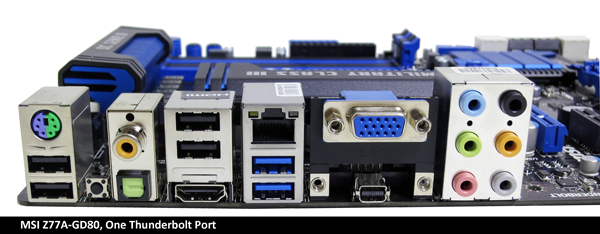Everything You Need To Know About Thunderbolt
Paving The Way For High-Performance External I/O
Despite a less-than-picturesque debut on the PC, Thunderbolt's raw performance is impressive. Boasting throughput close to 1 GB/s, ultra-speedy next-generation external storage solutions are now a reality. Much more than a simple enabler for big disks sitting outside of your machine, Thunderbolt also extends the PCIe bus beyond your motherboard, enabling innovation in some ways we've seen and others that will no doubt surprise us in the next year.
Perhaps its most glaring weakness, Thunderbolt is not well-suited to a value audience. Reminiscent of FireWire 800's debilitating premium, Seagate's Thunderbolt-based GoFlex adapter costs a staggering $190. In contrast, formerly-expensive FireWire 800 adapters hover in the $80 range and USB 3.0 adapters sell for a mere $30. You can thank the high price of Intel's Thunderbolt controllers for that, particularly since vendors don't include cables with their Thunderbolt-based devices. Plan on spending another $50 bucks just to make a connection between your new toy and motherboard.
Intel, however, says it's making a concerted effort to drive down costs with less expensive second-gen Thunderbolt controllers (Cactus Ridge and Port Ridge controllers), and it's providing subsidies for its technology partners to help cover costs.
Despite Thunderbolt’s technological sensibility and resulting performance advantages, enthusiasts should stick to their lower-cost storage controllers, SATA-based SSDs, and internal graphics cards. The number of applications we can think of that require Thunderbolt's capabilities is still tiny. You can achieve high-speed external storage using JBODs, and most folks don't find the limits of DVI cables to be all that constraining. Right now, Thunderbolt is a very niche technology on PC desktops, attractive to high-end audio and video professionals looking for a low-latency, high-bandwidth interface for moving large amounts of data quickly.
Thunderbolt is arguably more promising in the mobile space. We love our notebooks for their mobility. But they typically give up a lot in the way of performance and flexibility for those compact form factors. By externalizing PCI Express and DisplayPort, Thunderbolt has the potential to add fast storage, graphics upgrades, and nice big monitors to small computing devices that couldn't accommodate them before.
There's no doubt that Thunderbolt addresses many of the weaknesses plaguing today's external interfaces. And because of the standards on which Thunderbolt is based, the technology can do things outside of the chassis (be it a desktop or mobile form factor) that simply weren't possible before.
Get Tom's Hardware's best news and in-depth reviews, straight to your inbox.
Current page: Paving The Way For High-Performance External I/O
Prev Page Active Thunderbolt Cables Are Hot Cables-
mayankleoboy1 for more insight of thunderbolt fail and Intel's lying :Reply
http://semiaccurate.com/2012/06/06/intel-talks-about-thunderbolt/ -
shoelessinsight Active cables are more likely to have defects or break down over time. This, plus their high expense, is not going to go over well with most people.Reply -
mayankleoboy1 ^Reply
because "thunderbolt" sounds much sexier than "HDBaseT " ?
and with apple, its all about the sexiness, not functionality/practicality. -
JOSHSKORN Prediction: We will see Thunderbolt available on SmartPhones. When we do, this port will be able to handle a monitor, external hard drives, speakers and many other USB devices through its Thunderbolt docking station. Obviously a SmartPhone won't need to be attached to a webcam. This will become the future desktop...that is, if it can run Crysis. LOL Had to add that in there. :)Reply -
pepsimtl I remenber scsi interface ,so expensive ,just the company (server) use it .Reply
and sata interface replace it.
For me Thunderbolt is the same song
I predict a sata 4 (12gb) or usb 4 ,soon

